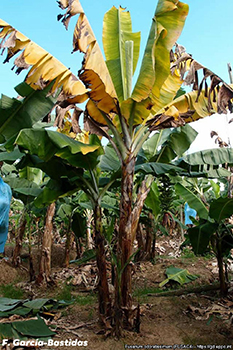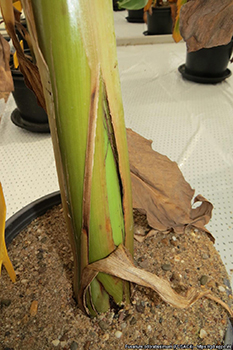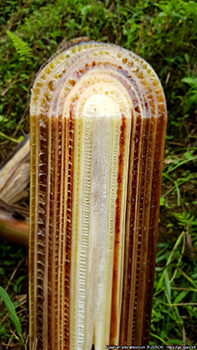
EPPO Alert List – Fusarium oxysporum f. sp. cubense Tropical race 4
Why
Fusarium wilt or Panama disease caused by Fusarium oxysporum f. sp. cubense is a severe fungal disease of banana, and a quarantine pest in most banana-producing countries. Four different races of F. oxysporum f. sp. cubense have been designated based on their pathogenicity to different reference varieties under field conditions. In particular, race 1 caused severe economic losses during the mid-20th century to the cultivation and trade of cultivar ‘Gros Michel’ in Central America and the Caribbean, until it was replaced by resistant Cavendish cultivars. In 1992 a new variant of F. oxysporum f. sp. cubense called the tropical race 4 (TR4) was identified in South-East Asia infecting a wide range of banana cultivars, including Cavendish clones. In 2019, it was proposed to consider TR4 as a distinct species called Fusarium odoratissimum, but this is still being detabed. In 2013, TR4 was reported for the first time in Africa, in Mozambique. In 2019, it was found in Colombia, which was the first finding in Latin America where approximately two thirds of the world banana trade originate. In the EPPO region, TR4 has been reported in Jordan (EPPO RS 2014/170), Israel (RS 2018/106 and 2019/059) and Türkiye (RS 2020/015). In Israel, the disease is subject to eradication measures. Considering the serious economic damage TR4 is inflicting to banana production and its limited occurrence in the EPPO region, it was felt useful to add TR4 to the EPPO Alert List.

Infected Cavendish banana plant in the Philippines
Courtesy: Fernando A. Garcia Bastidas

Pseudostem splitting.
Courtesy: Fernando A. Garcia Bastidas

Pseudostem of an infected suceptible banana plant.
Courtesy: Fernando A. Garcia Bastidas
Where
EPPO region: Israel, Jordan, Lebanon, Türkiye.
Africa: Comoros, Mayotte, Mozambique.
Asia: China (Fujian, Guangdong, Guangxi, Hainan, Yunnan), India (Bihar, Gujarat, Madhya Pradesh, Uttar Pradesh), Indonesia (Irian Jaya, Java, Kalimantan, Sulawesi, Sumatra), Israel, Japan (Ryukyu Archipelago), Jordan, Laos, Lebanon, Malaysia, Myanmar, Oman, Pakistan, Philippines, Taiwan, Thailand, Vietnam.
South America: Colombia, Peru, Venezuela.
Oceania: Australia (Northern Territory, Queensland), Micronesia, Tonga.
On which plants
Musa spp. TR4 has overcome the resistance to F. oxysporum f. sp. cubense in Cavendish clones and can attack other banana cultivars such as plantains, cooking bananas and a diverse range of dessert bananas which are major sources of food in tropical countries.
Damage
Affected banana plants show irregular yellowing of the margins of older leaves, which later turn brown, dry out and collapse around the pseudostem. Stem splitting can also be observed. Internal symptoms include yellow to reddish-brown discolouration of the vascular tissues. Affected plants show a wilted appearance and rarely produce marketable bunches.
Dissemination
F. oxysporum f. sp. cubense is a soil-borne fungus and it is considered that its clamydospores can survive for several years in the soil. Planting material, water, soil particles, tools, footwear and machinery can efficiently disseminate the fungus.
Pathways
Plants for planting, soil, soil contaminating tools, footwear, and machinery from countries where TR4 occurs.
Possible risks
It is generally accepted that TR4 represents one of the biggest threats to banana production worldwide. There are no curative treatments, and it is estimated that most banana cultivars commercially grown are susceptible to the disease. Research is being carried out to produce tolerant or resistant banana varieties, but this is part of a long-term strategy. It is thus essential to avoid the introduction of TR4 into areas that are still free from it. In the EPPO region, banana production is limited to its warmer parts, such parts of the Mediterranean Basin (e.g. Canary Islands (ES), Cyprus, Greece, Israel, Italy, Jordan, Madeira (PT), Morocco, Türkiye). The fact that TR4 has been detected in restricted areas around the Mediterranean Basin shows that it has the potential to enter the region. In its risk assessment for the European Union, EFSA concluded that TR4 has the characteristics of a quarantine pest for the European Union. As the economic impact of TR4 is expected to be high, it could be advised that banana-growing countries in the EPPO region take measures against this pathogen. It should be noted that FAO and the IPPC are coordinating many actions against this disease including workshops, websites, communication material, and guidelines to help NPPOs preparing their response to TR4 outbreaks should they occur on their territory.
Sources
Anses (2021) Avis de l’Anses sur les cahiers des charges relatifs aux obligations incombant aux établissements producteurs de vitroplants (VP) de bananiers à destination des Départements d'Outre Mer, et aux conditions d’acclimatation sur ces mêmes territoires. 62 pp. https://www.anses.fr/fr/system/files/SANTVEG2020SA0119Ra.pdf
Australian Governmant. Department of Agricultural, Fisheries and Forestry. Panama disease Tropical race 4. https://www.agriculture.gov.au/biosecurity-trade/pests-diseases-weeds/plant/panama-disease-tropical-race-4
EFSA PLH Panel (2022) Scientific Opinion on the pest categorisation of Fusarium oxysporum f. sp. cubense Tropical Race 4. EFSA Journal 20(1), 7092, 32 pp. https://doi.org/10.2903/j.efsa.2022.7092
García-Bastidas N, Ordóñez F, Konkol J, Al-Qasim M, Naser Z, Abdelwali M, Salem N, Waalwijk C, Ploetz RC, Kema GHJ (2014) First report of Fusarium oxysporum f. sp. cubense tropical race 4 associated with Panama disease of banana outside Southeast Asia. Plant Disease 98(5), p 694.
Gubbuk H, Altınkaya L, Balkıç R (2017) Banana: a very profitable tropical crop for Turkey. Chronica Horticulturae 57(2), 20-25.
IPPC Secretariat (2023) Prevention, preparedness and response guidelines for Fusarium Tropical Race 4 (TR4) of banana. Rome, FAO on behalf of the Secretariat of the International Plant Protection Convention. https://www.fao.org/documents/card/en/c/cc4865en
Maryani N, Lombard L, Poerba YS, Subandiyah S, Crous PW, Kema GHJ (2019) Phylogeny and genetic diversity of the banana Fusarium wilt pathogen Fusarium oxysporum f. sp. cubense in the Indonesian centre of origin. Studies in Mycology 92, 155-194. https://doi.org/10.1016/j.simyco.2018.06.003
Mmadi M, Azali HA, Mostert D, Robène I, Viljoen A (2023) First report of Fusarium wilt of Cavendish bananas caused by Fusarium oxysporum f. sp. cubense Tropical Race 4 in the Grande Comoros Island. Plant Disease (early view). https://doi.org/10.1094/PDIS-07-23-1288-PDN
Torres Bedoya E, Bebber DP, Studholme DJ (2021) Taxonomic revision of the banana Fusarium wilt TR4 pathogen is premature. Phytopathology 111(12), 2141-2145.
TR4 Global Network – an initiative for the World Banana Forum. https://www.fao.org/tr4gn/en/
van Westerhoven AC, Meijer HJ, Houdijk J, Martínez de la Parte E, Matabuana EL, Seidl MF, Kema GH (2023) Dissemination of Fusarium wilt of banana in Mozambique caused by Fusarium odoratissimum Tropical Race 4. Plant Disease 107(3), 628-632. https://doi.org/10.1094/PDIS-07-22-1576-SC
Viljoen A, Mostert D, Chiconela T, Beukes I, Fraser C, Dwyer J, Murray H, Amisse J, Matabuana EL, Tazan G, Amugoli OM (2021) Occurrence and spread of the banana fungus Fusarium oxysporum f. sp. cubense TR4 in Mozambique. South African Journal of Science 116(11-12), 1-11. http://dx.doi.org/10.17159/sajs.2020/8608
EPPO RS 2023/090, 2023/103, 2023/221
